Growing Jelly And Jam At Home: How To Grow A Jelly Garden

Currently, there is a resurgence of interest in canning and this includes canning one’s own preserves. Sure, you can buy them. Or you can pick your own fruit to make jam or jelly. It’s even more fun to grow your own preserves by growing a jelly and jam garden. To grow your own jams and jellies, you need to cultivate your own fruit.
What is a Jelly and Jam Garden?
A jam and jelly garden is simply a garden that includes fruit that can be used to make these preserves. The most common plants to include are berry plants, but why stop there? Interestingly, there are a number of other plants that can be included to grow your own preserves.
How to Grow a Jelly Garden
Arguably one of the most popular jellies is grape jelly and if you have the space to grow grapes, do so. They not only provide gorgeous color and height but can shield the landscape from prying eyes as well.
As far as jams go, strawberry jam is the classic jam for many folks. Strawberries are fairly easy to grow and quite prolific giving the gardener plenty of fruit to preserve in a relatively short period of time.
Other berries commonly used to make jams include boysenberry, raspberry, and blackberry. If you have a large enough landscape, include berries such as mulberry, marionberry, or blueberry. Or grow your own jams and jellies by planting elderberry and currant bushes.
If space is an issue, blueberries and strawberries do beautifully container grown.
Those with larger properties may already be growing jelly and jam-producing native plants such as Aronia. Aronia is native to much of eastern North America and while it is edible, it takes the addition of sugar to make it tasty. Plus, Aronia is something of a superfood.
Gardening tips, videos, info and more delivered right to your inbox!
Sign up for the Gardening Know How newsletter today and receive a free copy of our e-book "How to Grow Delicious Tomatoes".
Other Options to Grow Your own Jams and Jellies
Don’t forget trees when growing jelly and jam gardens! Cherries, apples, and pears grow in a wide array of zones, while in warmer regions peaches, oranges, and lemons can be grown.
You can grow your own preserves even if you have a smaller landscape or none at all by growing dwarf varieties in pots. Meyer lemon, for instance, grows beautifully in a pot and can be brought inside to overwinter as do several other citrus varieties.
If you have a veggie garden, chances are good that you are growing produce that is ideal for preserves. For instance, pepper jelly is made from spicy peppers and adds a sweet kick to a variety of foods.
If you are growing corn already, don’t throw away the corn cobs. Use corn cobs to make old-time corn cob jelly. A perfect example of ‘waste not want not,’ corn cob jelly has a delightful, honey-like flavor.
For those that like their preserves with a twist, think outside the box and incorporate flowers such as lilacs, honeysuckle, violets, or lavender. These blooms will not only beautify the landscape but entice pollinators too.
Lastly, while you may not purposely plant them, many weeds can be used to make delicious preserves. The next time you’re digging up clover, Queen Anne’s lace, or dandelions, think before disposing of them. These unwelcome plants may just find a new home in the kitchen, or rather, on a piece of toast.

Amy Grant has been gardening for 30 years and writing for 15. A professional chef and caterer, Amy's area of expertise is culinary gardening.
-
 8 Noteworthy Native Azaleas Every Gardener Should Know – And Grow!
8 Noteworthy Native Azaleas Every Gardener Should Know – And Grow!Native azaleas offer brilliant blooms in a range of colors and sizes. Here are a few favorites to get inspired and start working on a native shade garden!
-
 Growing Climbing Roses: How To Create Elegant Displays With Maximum Blooms
Growing Climbing Roses: How To Create Elegant Displays With Maximum BloomsMaster the art of growing stunning climbing roses with this essential guide to creating vibrant, fragrant walls and structures all summer long.